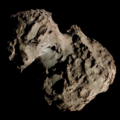Observational history
The comet was discovered by amateur astronomer William A. Bradfield from Yankalilla, South Australia on 23 March 2004 with a 0.25-m reflector telescope, during his search for sungrazing comets. That was Bradfield's 18th comet discovery. The comet was then located in evening twilight and its magnitude was estimated to be about magnitude 8. Robert H. McNaught observed the comet on 9 April 2004 and estimated that the comet had a magnitude of 5, while Terry Lovejoy estimated its magnitude to be 3.3 on 12 April, while its tail measured half a degree long. [1] At that time, two more naked eye comets were visible in the sky, C/2001 Q4 (NEAT) and C/2002 T7 (LINEAR). [5]
The comet reached perihelion on 17 April 2004, at a distance of 0.168 AU (25.1 million km; 15.6 million mi). [2] The comet became visible in the C3 coronograph of the Solar and Heliospheric Observatory (SOHO) between 16 and 20 April 2004. [6] The comet had a bright head and a long white tail. [7] The appearance of the comet in the coronograph was unusual, with the coma growing perpendicularly to the apparent motion, and thus indicating a growing dust tail, while on 19 April a series of structures were seen near the head, probably streamers or striae. If these were streamers, they indicated an uprise in activity every 0.5 day. [4] The orbital ephemeris based on the SOHO observations indicated that the comet on 20 April had a magnitude of 2.5. [4]
The comet was spotted in bright twilight on 22 April, when the comet had an estimated magnitude of about 4 to 4.5. [8] On 25 April, while the comet was estimated to have a same magnitude, its tail was estimated to 8.5 degrees long with naked eye, while on 27 April the tail length was estimated to be 10 degrees with 7×35 binoculars, while the comet was estimated to have a magnitude of 5. On 30 April the apparent magnitude was estimated to be 5.8 while the tail was estimated to be 3.5 degrees long. [9]
On 2–3 May, Earth crossed the orbital plane of the comet. As a result, a sunward spike (or anti-tail) and a ray-shaped structure in the dust tail. [10]
This page is based on this
Wikipedia article Text is available under the
CC BY-SA 4.0 license; additional terms may apply.
Images, videos and audio are available under their respective licenses.




